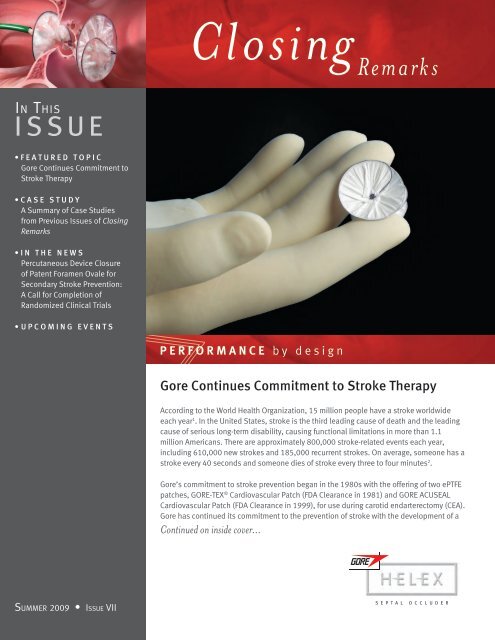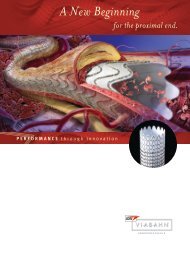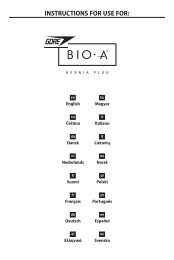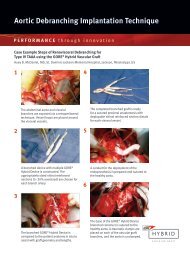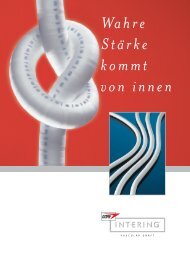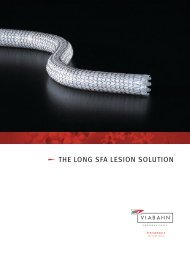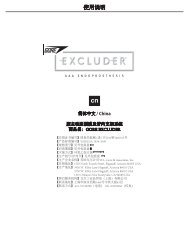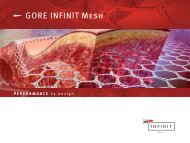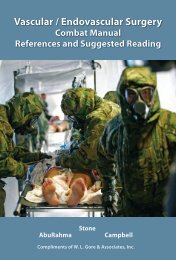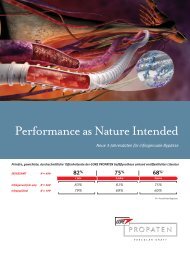Closing Remarks Newsletter - Summer 2009 - Gore Medical
Closing Remarks Newsletter - Summer 2009 - Gore Medical
Closing Remarks Newsletter - Summer 2009 - Gore Medical
Create successful ePaper yourself
Turn your PDF publications into a flip-book with our unique Google optimized e-Paper software.
<strong>Closing</strong> Remark sIn Th i sISSUE• FEATURED TOPIC<strong>Gore</strong> Continues Commitment toStroke Therapy• CASE STUDYA Summary of Case Studiesfrom Previous Issues of <strong>Closing</strong><strong>Remarks</strong>• In The NewsPercutaneous Device Closureof Patent Foramen Ovale forSecondary Stroke Prevention:A Call for Completion ofRandomized Clinical Trials• Upcoming EventsPERFORMANCE by design<strong>Gore</strong> Continues Commitment to Stroke TherapyAccording to the World Health Organization, 15 million people have a stroke worldwideeach year 1 . In the United States, stroke is the third leading cause of death and the leadingcause of serious long-term disability, causing functional limitations in more than 1.1million Americans. There are approximately 800,000 stroke-related events each year,including 610,000 new strokes and 185,000 recurrent strokes. On average, someone has astroke every 40 seconds and someone dies of stroke every three to four minutes 2 .<strong>Gore</strong>’s commitment to stroke prevention began in the 1980s with the offering of two ePTFEpatches, GORE-TEX ® Cardiovascular Patch (FDA Clearance in 1981) and GORE ACUSEALCardiovascular Patch (FDA Clearance in 1999), for use during carotid endarterectomy (CEA).<strong>Gore</strong> has continued its commitment to the prevention of stroke with the development of aContinued on inside cover...Su m m e r <strong>2009</strong> • Is s u e VII
<strong>Gore</strong> Continues Commitment to Stroke Therapy...continued from page 1family of endovascular products. TheGORE HELEX Septal Occluder is currentlybeing investigated within a randomizedclinical trial (<strong>Gore</strong> REDUCE ClinicalStudy * ) to assess the reduction ofrecurrent cryptogenic stroke in patientswith patent foramen ovale (PFO). <strong>Gore</strong> isalso focused on interventional therapiesfor carotid artery disease, beginningwith the development of a unique neuroprotection platform for use duringcarotid artery angioplasty and stenting.Figure 1: GORE Flow Reversal System, continuouslydirects macro and micro emboli away fromthe brain during flow reversal.To date, CEA is considered the standardof care for carotid revascularization, butcarotid artery stenting (CAS) is becomingmore of an alternative to surgery. Datashowing that CEA produces fewerperiprocedural embolic events than CASindicates one area where the proceduralsafety profile of CAS can be improved 3,4 .The most commonly used type of neuroprotection devices are filters, whichare positioned distal to the lesion priorto stenting. Distal filters have knownlimitations, such as requiring to betracked though the target lesion inorder for protection to be established,which increases the risk of generatingemboli. In addition, the filter porosityneeded to allow for antegrade flowand / or sub-optimal wall appositionmay result in micro emboli beingreleased to the neurovasculature.Moreover, distal internal carotid artery(ICA) vessel tortuosity may impedeproper placement of the filter andoverfilling of the filter with embolicdebris may result in slow blood flow,potential patient intolerance, and therelease of debris during filter retrieval.<strong>Gore</strong> is focused on the developmentof technologies thatpromise to reduceor eliminate thesesources of periproceduralembolic riskduring CAS.The GOREFlow ReversalSystem is aunique embolicprotection systemthat operates on theprinciple of reversing theflow of blood at the treatment site. Theconcept that flow reversal could be usedto provide cerebral protection duringCAS was developed by Juan Parodi,MD in collaboration with Mark Bates,MD, Claudio Schönholz, MD, and TakOhki, MD. Flow reversal is achieved bytemporarily occluding antegrade bloodflow in the common carotid and externalcarotid artery, similar in many ways toclamping during CEA. By establishinga shunt between the carotid artery andfemoral vein, blood from the collateralvessels is redirected to the lowerpressure venous return, resulting in flowreversal at the treatment site. Redirectedblood is filtered outside the body beforebeing reintroduced into the venoussystem (Figure 1). With flow reversalestablished, the GORE Flow ReversalSystem continuously directs both macroand micro emboli away from the brain,minimizing the risk of emboli reachingthe brain throughout critical stages ofthe CAS procedure. Because the systemis positioned proximal to the targetlesion, protection is established beforeinteracting with the lesion, minimizingthe risk of emboli being generated whileestablishing protection. In addition,use of the GORE Flow Reversal Systemeliminates concerns about distal vesseltortuosity and finding a suitable landingzone for a distal filter, and allows thephysician to use their guidewire ofchoice.Successful use of the original flowreversal device was reported in severalseries, including a 200 patient studythat reported a perioperative strokeand death rate of 1.5% 5 . In the <strong>Gore</strong>EMPiRE Clinical Study ** the safety andefficacy of the GORE Flow ReversalSystem during CAS was assessed inpatients at high risk for CEA. Twentynine(29) US sites participated in thestudy and enrolled 245 pivotal subjectsbetween July 2006 and July 2008. Thepatient population treated included32% symptomatic patients and 16%octogenerian patients. The primarystudy endpoint Major Adverse Events(MAE) was a composite of death,stroke, transient ischemic attack (TIA),
or myocardial infarction (MI) throughthe 30-day post-procedure follow-up.The MAE rate for the study was 4.5%.The 30-day stroke, death, and MI ratewas 3.7% and the death / any strokerate was 2.9%. Importantly, the studyalso showed 0% major ischemic stroke.The results in some of the historicallymost challenging patient populationsfor CAS were encouraging with a lowdeath, stroke, and MI rate of 2.6% foroctogenarians and 3.8% for symptomaticpatients. The death / any stroke rate forsymptomatic and asymptomatic patientsin this study was also low at 2.6% and3.0%, respectively. The <strong>Gore</strong> EMPiREClinical Study is one of the first carotidartery stenting studies that reporteddeath / stroke rates that are within theAmerican Heart Association guidelinesfor CEA of 3% for asymptomatic patientsand 6% for symptomatic patients 6 . TheGORE Flow Reversal System received FDAclearance on February 4, <strong>2009</strong>.In addition to the GORE Flow ReversalSystem, <strong>Gore</strong> has developed a distalfilter that is designed to limit the escapeof debris between the filter and thevessel wall, with enhanced vessel wallapposition, and circumferential supportof the filter media (Figure 2). In vitrotesting showed that the GORE EmbolicFilter performs well in straight anatomyand maintains its performance inrepresentative tortuous anatomy (Figure3). The GORE Embolic Filter is currentlybeing studied in an IDE trial in the US inthe <strong>Gore</strong> EMBOLDEN Clinical Study *** .With a nearly 30 year history indeveloping and bringing products tomarket that prevent stroke, <strong>Gore</strong> hasshown a continuing commitment toproviding physicians with tools thatDiamond FrameCircumferential FilterAttachmentConformable HeparinCoated ePTFE Media with100 micron PoresFigure 2 GORE Embolic Filter, designedto improve filter efficiency.improve patient outcomes. Withpromising data for the GORE FlowReversal System and initiation of a studyevaluating the GORE Embolic Filter andGORE HELEX Septal Occluder, <strong>Gore</strong> iscommitted to raising the bar for strokeprevention and future therapies.In Vitro Filter Efficiency Evaluations AFilter Efficiency (%)100908070605040DeviceStraight20 mm CurveTest ConfigurationFigure 3 The GORE Embolic Filter not only performswell in GORE straight Embolic vessels, FIlter but ACCUNET also maintainsDeviceperformanceFILTERWIREwhen deployedEZ DeviceinANGIOGUARDtight curves thatSpideRXDeviceare representative of tortuous clinical anatomy.Embro Sheild ProCaution: GORE Embolic Filter is an InvestigationalDevice. Limited by United States Law toInvestigational Use.nPoreSize(microns)ParticleSize(microns)GORE Embolic Filter 72 100 116FILTERWIRE EZ Device 8 110 116RX ACCUNET ® Device 4 120 143ANGIOGUARD RX Device 4 100 116SPIDERX Device 4 50 – 300 B 240EmboShield PRO Device 3 120 143A Data on FileB Karnabatidis D, Katsanos K, Kagadis GC, et al.Distal embolism during percutaneousrevascularization of infra-aortic arterial occlusive disease: an underestimatedphenomenon. Journal of Endovascular Therapy 2006;13(3):269-280.<strong>Gore</strong> has prepared a specialCD that discusses the GOREFlow Reversal System. For acopy of the CD, please e-mail<strong>Closing</strong><strong>Remarks</strong>@wlgore.com.*REDUCE: GORE HELEX Septal Occluder andAntiplatelet <strong>Medical</strong> Management for Reductionof Recurrent Stroke or Imaging-Confirmed TIA inPatients with Patent Foramen Ovale (PFO)**EMPIRE: Embolic Protection with ReverseFlow Study of the GORE Flow Reversal Systemin Carotid Stenting of Subjects at High Risk forCarotid Endarterectomy***EMBOLDEN: GORE Embolic Filter in CarotidStenting for High Risk Surgical SubjectsREFERENCES1.World Health Organization. Global burden of stroke.http://www.who.int/cardiovascular_diseases/en/cvd_atlas_15_burden_stroke.pdf Accessed August 18,<strong>2009</strong>.2.Lloyd-Jones D, Adams R, Carnethon M, et al; AmericanHeart Association Statistics Committee and StrokeStatistics Subcommittee. Heart disease and strokestatistics-<strong>2009</strong> update: a report from the AmericanHeart Association Statistics Committee and StrokeStatistics Subcommittee. Circulation <strong>2009</strong>;119(3):480-486.3.Gossetti B, Gattuso R, Irace L, et al. Embolism tothe brain during carotid stenting and surgery. ActaChirurgica Belgica 2007;107(2):151-154 .4.Flach HZ, Ouhlous M, Hendriks JM, et al. Cerebralischemia after carotid intervention. Journal ofEndovascular Therapy 2004;11(3):251-257.5.Parodi JC, Schönholz C, Parodi FE, Sicard G, FerreiraLM. Initial 200 cases of carotid artery stenting usingreversal-of-flow cerebral protection device. Journal ofCardiovascular Surgery 2007;48(2):117-124.6.Hopkins LN Clair D; EMPiRE Investigators. EMPiRE:A multicenter registry evaluating neuroprotectionduring carotid stenting with a novel flow reversalsystem. Presented at the TCT 2008: TranscatheterCardiovascular Therapeutics 20th Annual ScientificSymposium; October 12 -17, 2008; Washington, DC.
A Summary of Case Studies fromPrevious Issues of <strong>Closing</strong> <strong>Remarks</strong>C A S E S T U D YCASE 1*Use of the GORE HELEX Septal Occluderfor the Percutaneous Closure of aMulti-Fenestrated Atrial Septal Defect,Michael Slack, MD, Washington, DCSuccessful implantation of a 25 mmGORE HELEX Septal Occluder in a 4.5year old female child to occlude afenestrated defect is described. Theseptum was characterized by two defectsmeasuring approximately 4 – 5 mm, atboth the inferior and superior edges of ananeurysm, as well as numerous (between6 and 9) additional ≤ 1 mm defectsinterspersed throughout the remainder ofthe atrial septum (Figure 1).Figure 1: 2D intracardiac echacardiographic color Doppler image showing large amount of left to rightshunting across multiple planes of the complex atrial septal aneurysm.CASE 2*Appearance of the GORE HELEX SeptalOccluder During Implantation,David Nykanen, MD, Orlando, FloridaEchocardiographic and fluoroscopicconsiderations during the implantationof a GORE HELEX Septal Occluder areprovided (Figure 2). Additionally, anunderstanding of the course of thenitnol wire that forms the occluder frameis conveyed in an effort to aid one’sinterpretation of these images duringa procedure.Figure 3: Frontal view of normal right atrial 3Danatomy. 1. Right superior vena cava 2. Rightatrium and appendage 3. Inferior vena cava4. Left innominate vein 5. Tricuspid valve.1.2. 4.Figure 2: Fluoroscopy image of the GORE HELEX Septal Occluder (cranially angulated left anterior obliqueprojection). The delivery sheath is withdrawn to the IVC / RA junction and the RA disc is formed, apposingit to the RA side of the septum. Note the central wire representing the locking portion of the device issheathed by the mandrel, maintaining it straight. The three central eyelets of the device are aligned andequidistant prior to setting the lock. Each atrial disc is formed by 1 ¼ turns of the helical circumferentialnitinol wire.CASE 3*Understanding Atrial Septal Rim Anatomy Using Echocardiography Prior toPlacement of the GORE HELEX Septal Occluder,James Mathewson, MD, Flagstaff, Arizona3.5.A review of atrial septal rim anatomy is provided (Figure 3) and correlated toechocardiographic imaging. Echocardiographic (both TTE and TEE) considerations areoffered to help one select appropriate patients for implantation of the GORE HELEXSeptal Occluder.
CASE 4*Occlusion of Secundum Atrial SeptalDefect (ASD) with Deficient RetroaorticRim and Atrial Septal Aneurysm Using a30 mm GORE HELEX Septal Occluder,Frank Ing, MD, Houston, TexasA case study describing the implantationof the GORE HELEX Septal Occluder ina 33-year-old patient is described. Thepatient’s ASD was found to be 11.5 mmby TEE and 14.5 mm by fluoroscopy,and its anatomy was characterized by adeficient retro-aortic rim. A 30 mm devicewas implanted without incident (Figure 4).Figure 4: TEE image following implantation of a 30 mm GORE HELEX Septal Occluder, the left and rightatrial discs splay securely around the aorta without impingement on the vessel.CASE 5*Combined Percutaneous Treatment forSecundum Atrial Septal Defect (ASD)and Patent Ductus Arteriosis (PDA) andImplantation of an Endocardial PacingLead in a Six-Year-Old Girl,Jaana Pihkala, MD, Helsinki, FinlandA case report describing multiplecongenital defects addressedsimultaneously by interventionalprocedures is provided (Figure 5). Thiscase additionally details the implantationof a 15 mm GORE HELEX Septal Occluderin an ostium secundum ASD.Figure 5: Fluoroscopy view of the GORE HELEX Septal Occluder fully deployed. A detachable coil has beenplaced in the PDA and an endocardial ventricular pacing lead in the right ventricle and the pacemaker inthe left pectorial region. The old epicardial atrial and ventricular pacing leads are still in place.CASE 6*Use of Live 3D Transesophageal Echocardiography to Evaluate and Guide Closureof a Secundum Atrial Septal Defect,Joseph Paolillo, MD, Gainesville, FloridaConsiderations for the use of 3D TEE during the implantation of the GORE HELEX SeptalOccluder is provided. The case study describes the successful implantation of thedevice in a 65-year-old patient having a 12 – 13 mm ASD (Video 1 * ).If you have a case study that you would like tofeature in a future issue of <strong>Closing</strong> <strong>Remarks</strong>,please contact your local <strong>Gore</strong> Sales Associate.Your participation will help continue to makethis newsletter a success!* The case studies and video files referenced inthese articles are available in our online version of<strong>Closing</strong> <strong>Remarks</strong>: http://www.goremedical.com/helex/library/newsletters.Video 1: Evaluation of the device with live 3D TEE,rotating from a profiled to an ‘en face’ view.
I N T H E N E W SPercutaneous Device Closure of Patent ForamenOvale for Secondary Stroke Prevention: A Call forCompletion of Randomized Clinical TrialsThe AHA / ASA issued a call to action to advocate for increased enrollment inPFO and cryptogenic stroke randomized clinical trials. The Science Advisory,jointly published in the Journal of the American College of Cardiology andCirculation this May, reviews observational and non-randomized PFO andcryptogenic stroke studies to substantiate the need for objective, randomizedclinical trial data to inform clinicians’ treatment decisions 1-2 .The AHA / ASA concurrently published the online advisory Top Ten Things toKnow: Percutaneous Device Closure of Patent Foramen Ovale for SecondaryStroke Prevention. The succinct overview can be shared with clinical partners,referring clinicians, patients, and families who encourage their participation inclinical trials.According to Scott Kasner, MD, FAHA, University of Pennsylvania <strong>Medical</strong>Center, and <strong>Gore</strong> REDUCE Clinical Study US Neurological Principal Investigator,this advisory emphasizes the need for clinicians to support well-designedrandomized clinical trials. “The use of MRI evidence in the <strong>Gore</strong> REDUCEClinical Study * for new relevant brain infarction as an endpoint establishes,from baseline, the rigor necessary to demonstrate evidence for this importantquestion,” Dr. Kasner said. “In addition, the protocol standardizes antiplatelettherapy in accordance with the 2007 US Food and Drug Administration (FDA)Circulatory Systems Devices Panel’s call for completion of randomized PFO /cryptogenic stroke trials 3 .”*REDUCE: GORE HELEX Septal Occluder and Antiplatelet <strong>Medical</strong> Management for Reduction of Recurrent Stroke or Imaging-ConfirmedTIA in Patients with Patent Foramen Ovale (PFO)REFERENCES1.Easton JD, Saver JL, Albers GW, et al ; American Heart Association; American Stroke Association Stroke Council; Council on CardiovascularSurgery and Anesthesia; Council on Cardiovascular Radiology and Intervention; Council on Cardiovascular Nursing;Interdisciplinary Council on Peripheral Vascular Disease. Definition and evaluation of transient ischemic attack: a scientific statementfor healthcare professionals from the American Heart Association/American Stroke Association Stroke Council; Council on CardiovascularSurgery and Anesthesia; Council on Cardiovascular Radiology and Intervention; Council on Cardiovascular Nursing; and theInterdisciplinary Council on Peripheral Vascular Disease. The American Academy of Neurology affirms the value of this statement as aneducational tool for neurologists. Stroke <strong>2009</strong>;40(6):2276-2293.2.O’Gara PT, Messe SR, Tuzcu EM, Catha G, Ring JC; American Heart Association; American Stroke Association; American College ofCardiology Foundation. Percutaneous device closure of patent foramen ovale for secondary stroke prevention: a call for completionof randomized clinical trials: a science advisory from the American Heart Association/American Stroke Association and the AmericanCollege of Cardiology Foundation. Circulation <strong>2009</strong>;119(20):2743-2747.3.Slottow TL, Steinberg DH, Waksman R. Overview of the 2007 Food and Drug Administration Circulatory System Devices Panel meetingon patent foramen ovale closure devices. Circulation 2007;116(6):677-682.REDUCECLINICAL STUDYCaution: Investigational Device. Limited by United States Lawto Investigational Use for the Indication of Patent Foramen Ovale (PFO).
“... the protocol standardizes antiplatelet therapyin accordance with the 2007 US Food and DrugAdministration (FDA) Circulatory Systems Devices Panel’s call forcompletion of randomized PFO / cryptogenic stroke trials 3 .”— Scott Kasner, MD, FAHA, University of Pennsylvania <strong>Medical</strong> Center,<strong>Gore</strong> REDUCE Clincal Study US Neurological Principal Investigator
U P C O M I N G E V E N T SPlease Join Us...September 8 – 9, <strong>2009</strong>Atrial Septal Defect Closure Course, San Donato, ItalyThis GORE MEDICAL MASTERY SERIES course* will feature distinguished facultyincluding Mario Carminati, MD, Andrew Cook, MD, Gianfranco Butera, MD, MassimoChessa, MD, Ted Feldman, MD, and Oliver Ormerod, MD, among others.September 20 – 25, <strong>2009</strong>Transcatheter Cardiovascular Therapeutics <strong>2009</strong>, San Francisco, California<strong>Gore</strong> Booth #605October 8 – 9, <strong>2009</strong>Atrial Septal Defect Closure Course, Cedars Sinai <strong>Medical</strong> Center, LosAngeles, CaliforniaThis GORE MEDICAL MASTERY SERIES course* will feature distinguished facultyincluding Ziyad Hijazi, MD, Tom Forbes, MD, Saibal Kar, MD, and Phil Moore, MD.* Topics include a device overview, clinical data, live cases, and hands-ondemonstrations. Contact your local <strong>Gore</strong> Sales Associate for details.If you have a topic that you would like us to consider in a future issue of <strong>Closing</strong> <strong>Remarks</strong>,please contact your local <strong>Gore</strong> Sales Associate or e-mail <strong>Closing</strong><strong>Remarks</strong>@wlgore.comW. L. <strong>Gore</strong> & Associates, Inc.Flagstaff, AZ 86004+65.67332882 (Asia Pacific) 800.437.8181 (United States)00800.6334.4673 (Europe) 928.779.2771 (United States)goremedical.comIndications for Use: The GORE Flow Reversal System is intended to provide embolic protection during carotid artery angioplasty and stenting for those patients diagnosed with carotid artery stenosis and who haveappropriate anatomy as described in the Instructions for Use. Refer to the Instructions for Use at goremedical.com for contraindications, warnings and precautions.Indications for Use in the US: The GORE HELEX Septal Occluder is a permanently implanted prosthesis indicated for the percutaneous, transcatheter closure of ostium secundum atrial septal defects (ASDs).Indications for Use Outside the US: The GORE HELEX Septal Occluder is a permanently implanted prosthesis indicated for the percutaneous, transcatheter closure of atrial septal defects (ASDs), such as ostiumsecundum and patent foramen ovale. Refer to Instructions for Use at goremedical.com for a complete description of all contraindications, warnings, precautions and adverse events.Products listed may not be available in all markets.RX ACCUNET ® and EMBOSHIELD PRO are trademarks of Abbott Laboratories.ANGIOGUARD RX is a trademark of Cordis Corporation.FILTERWIRE EZ is a trademark of Boston Scientific Corporation.SPIDERX is a trademark of ev3 Inc.GORE, HELEX, and designs are trademarks of W. L. <strong>Gore</strong> & Associates.© <strong>2009</strong> W. L. <strong>Gore</strong> & Associates, Inc. AN0781-EN1 AUGUST <strong>2009</strong>


